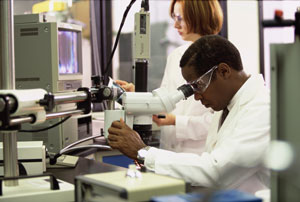Curing Cancer through Financial Engineering

Financial engineering and its toolkit of derivatives earned a bad reputation during the financial crisis of 2008. But financial engineering simply is solving financial problems with mathematical techniques, which usually means trading and distributing risk, as explained in a recent Economic Synopses essay.
Assistant Vice President and Economist Christopher Neely examined recent literature on the value of financial engineering in funding medical research. Medical research projects are typically very expensive and risky. The ones that earn money may earn a very large amount, but the vast majority earn nothing at all.
A route such as selling stocks in individual projects would likely prove too expensive for individual investors to research. Even large established firms may not be able to handle the risk of such a direction. Recent literature, however, suggests that financial engineering techniques may provide a solution. The authors of several papers proposed a large fund with the expertise to properly evaluate and finance a diversified group of medical projects.1
Scale and Funding
The scale and diversification would be key, given the expense and risk involved with investing in such projects. The authors proposed a $30 billion fund that could finance 150 projects at $200 million each. As Neely noted in his Economic Synopses essay, “Investing in a group of risky projects is much less risky than investing in an individual project because some projects will succeed, even if most projects will fail.”
The authors of the papers analyzed by Neely used the historical success rates for cancer treatment projects and estimated that a portfolio of 150 projects that have a 5 percent chance of success would have an expected-return-to-volatility ratio (also called a Sharpe ratio) roughly comparable to that of the stock market.
However, such a fund would also make up a large portion of the U.S. venture capital market. (In 2010, the market totaled $176 billion.) Much of the funding of a fund this size would need to come from the long-term bond market, especially investment-grade 10- or 20-year bonds. He wrote, “Financial instruments, such as tranching and bond insurance (credit default swaps), could tailor the risk to different types of investors, opening the door to a wider group of investors.”
Less Capital-Intense Options
Additional research showed that the fund may not need to be this large.2 Research projects could, for example, tap into traditional funding sources for later stages of development. Only $5 billion would be sufficient for a cancer research fund, while a fund for research in ‘orphan’ diseases would need as little as $575 million to achieve an attractive risk-return ratio.
Neely concluded, “These authors make a compelling case that if financial engineering can distribute the pecuniary risk of medical research, then it can play a role in curing cancer.”
Notes and References
1 Fernández, José-Maria; Stein, Roger M.; and Lo, Andrew W. “Commercializing Biomedical Research through Securitization Techniques,” Nature Biotechnology, October 2012, Vol. 30, No. 10, pp. 964-75. Fagnan, David E.; Fernández, José-Maria; Lo, Andrew W.; and Stein, Roger M. “Can Financial Engineering Cure Cancer?” American Economic Review, May 2013, Vol. 103, No. 3, pp. 406-11.
2 Fagnan, David E.; Gromatzky, Austin A.; Stein, Roger M.; Fernández, José-Maria; and Lo, Andrew W. “Financing Drug Discovery for Orphan Diseases,” Drug Discovery Today, May 2014, Vol. 19, No. 5, pp. 533-38.
Additional Resources
- Economic Synopses: Financial Engineering Versus Cancer
- On the Economy: Lifetime Education Benefits Have Never Been So High
- On the Economy: Why Does the U.S. Have Such a Large Trade Deficit with China?
Related Topics
This blog offers commentary, analysis and data from our economists and experts. Views expressed are not necessarily those of the St. Louis Fed or Federal Reserve System.
Email Us
All other blog-related questions


